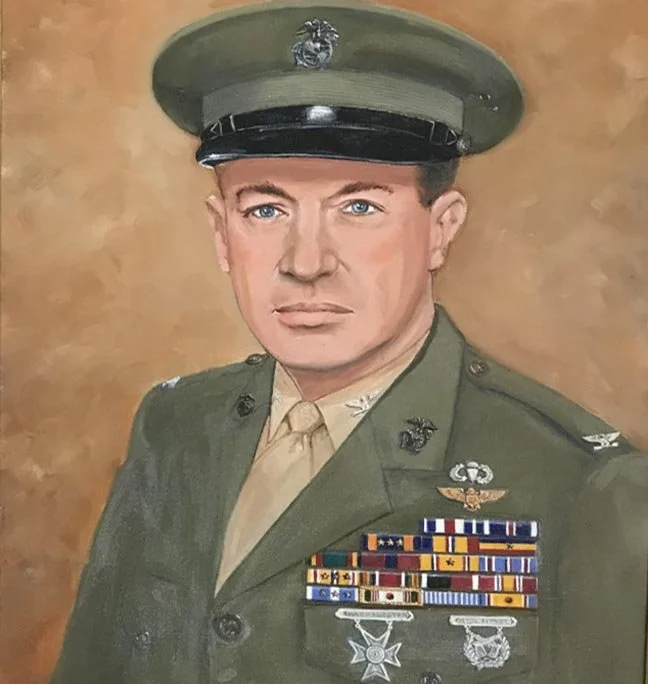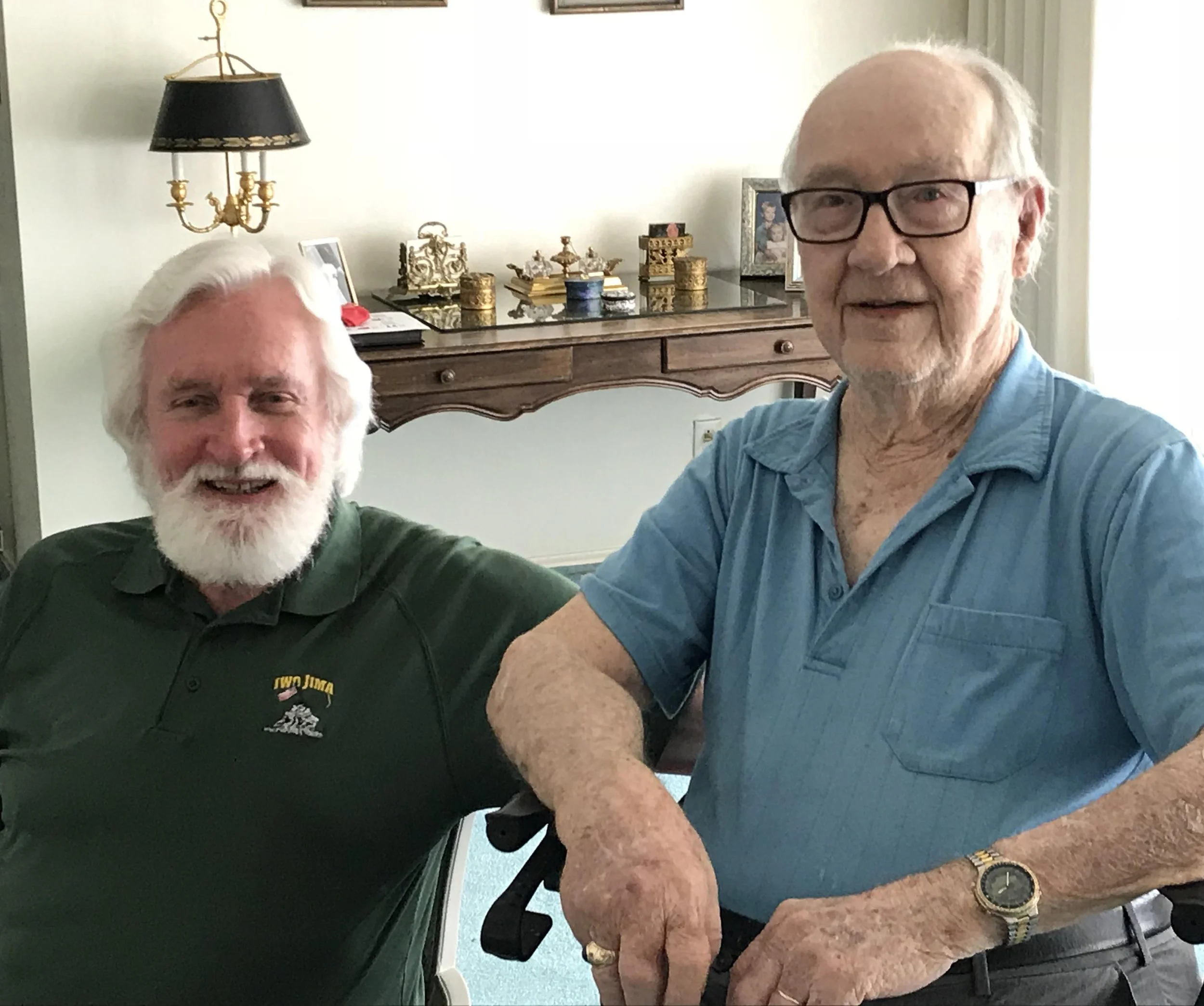Friendship with company commander of Iwo Jima flag-raisers leads to new book
During the years I edited the national newsletter for the 5th Marine Division Association (2008-2019), the subject of the famous flag raising on Mount Suribachi during the World War II battle of Iwo Jima came up often. That’s because the Marines who were involved were from that division, and Associated Press combat photographer Joe Rosenthal took a photo of what was the second flag raising that became one of the most iconic and recognizable images of all time.
In one issue of the newsletter — I don’t remember which anymore — Col. Dave E. Severance, USMC (Ret.), who had been the commanding officer of the men who raised the flags (Easy Company, 2nd Battalion, 28th Marine Regiment), thought I had made a mistake.
He brought that to the attention of the previous newsletter editor, who was also an Iwo Jima veteran, and said what I had conveyed was just another of what Severance had come to call “flag freak” stories — of which there have been many over the years — by people who perpetuated false claims about somehow being involved in the flag raisings.
Col. Dave E. Severance, USMC (Ret.)
I called him, identified myself, asked about his concerns and said if I had made a mistake, I’d correct it.
I do remember him saying, “Oh, I may have exaggerated that a little. It wasn’t one of them (a flag freak story).” And after a very cordial conversation, he said, “Now, you know my mother was an Elliott, don’t you?”
Of course, I didn’t.
That was sometime in 2011 or ’12, and so began a friendship with him and his wife, Barbara, who died in 2017, and which continued until Severance died at age 102 on Aug. 4, 2021. I had visited him several times when I was in southern California for business or vacation. We spoke on the phone and wrote letters in which he usually referred to me as “Cuz.” I recorded two interviews with him about the Iwo Jima campaign. He gave me books about Iwo Jima and told me about others. One he thought the best was “Iwo” by Richard Wheeler, one of his men from E/2/28. I gave him my novels, and he’d tell me his response.
A couple years before his death, Severance started talking with me about the prospect of publishing his memoir, “My Iwo Jima Saga.” He sent me the manuscript on a CD and a box of more than 60 folders containing documentation of those “flag freak stories” he described, which mostly came from military veterans and their families, as well as some poorly researched, far-fetched tales that were published or aired in the media.
One of the most egregious claims was from a man whose story was televised in a Spokane, Wash., newscast on Memorial Day 1992 that he’d flown a P-38 twin-engine fighter plane from Hawaii to Iwo Jima during the battle and landed near the base of Mount Suribachi with a flat tire and out of fuel. He saw a group of Marines carrying a pipe with a U.S. flag attached, followed them up the volcano and helped them raise the flag before returning to his aircraft. The Marines fixed his tire, refueled his plane, and he took off. The story was supposedly verified by somebody at the Pentagon.
Severance, who became a pilot after Iwo Jima, laughed when he recalled that story, pointing out that the P-38 only had a range of about one-third of the nearly 4,000 miles between Hawaii and Iwo Jima.
“And there was no in-air refueling back then,” he added.
Also, all refueling on the island at that time would have been from 5-gallon cans and would have required 80-100 cans of aviation gasoline strained through a chamois cloth into the P-38 fuel tank to fly to the nearest land 700 miles away. And flat tires on a plane are not patched, but rather the whole wheel is replaced with a new tire.
The debunking of stories such as this were included in Severance’s manuscript because he believed it was important to preserve and protect the true history of what his men actually did during the battle — and many of whom died. Over time, Severance accumulated volumes of correspondence correcting the record when warranted, including from people who reached out to him directly seeking more information about a family member only to be disappointed when he could not corroborate their claims.
Ray Elliott visited Severance at his home in La Jolla, California, during family vacations and veterans reunions.
Among many other inquiries he received about Iwo Jima over the years, the colonel served as a consultant for director Clint Eastwood on the 2006 film, “Flags of Our Fathers,” and was portrayed in the movie by actor Neal McDonough.
At the time of the landing on Iwo Jima, Severance said had no idea of the fame the men from his company would attain for raising the flags on Mount Suribachi five days later.
“We had nearly 30 percent casualties those first few days,” he said. “Our CP (command post) was set up at the base of Suribachi, and we were headed north. The vantage from Suribachi, and the fire from various spots there, made it necessary to secure the mountain.”
So when battalion commander Lt. Col. Chandler Johnson told then-Capt. Severance to send a group up Mount Suribachi to secure and occupy it, he sent a 40-man patrol led by Lt. Harold “George” Schrier, along with an American flag the colonel wanted raised, if possible. The patrol found a pole, fastened the flag to it and raised it at about 10:30 a.m.
“That boosted our morale,” Severance said. “The Marines below the mountain cheered and hollered, and the ships at sea blasted horns and clanged bells and whistles, mistakenly thinking the battle was over that actually raged on for more than 30 days.
Soon afterward, because the Secretary of the Navy, James Forrestal, said he wanted the flag, Lt. Col. Johnson had the first flag replaced with a second, larger flag but the first flag remained in the possession of the battalion, according to Severance. It was the second flag raising that was later pictured in Joe Rosenthal’s Pulitzer Prize-winning photo.
“We didn’t think more about it,” Severance said, “ until a couple of weeks later when they wanted the men identified from the second flag raising to take back for the (war) bond tour.”
And for much of the remainder of his long life, Severance was often asked about the famous flag raising and the 40-man patrol, including responding to a large number of claims from men (or their families) who said they were a flag raiser or were part of the patrol or helped supply the flag, etc.
“If everybody who said they were on the mountain then were there, the whole mountain would have sunk into the ocean,” he told me and others over the years. But he eventually grew tired of talking about the matter. “I’m fed up with the whole flag thing.”
One set of facts has been clear and constant from the start: Col. David E. Severance’s distinguished and storied career began when he enlisted in the Marine Corps in 1938, later received a commission, served with the 1st Parachute Battalion and fought on Bougainville. After the Paramarines were disbanded, he later joined the newly formed 5th Marine Division and received the Silver Cross on Iwo Jima, then became a Marine aviator and received the Distinguished Flying Cross in Korea, where he flew more than 60 missions.
“I don’t know what I did to deserve those awards,” he told me humbly, as many do who have fought for our freedom, seen a lot of violent death and survived.
Having worked with Severance, and later with his niece and executor, “My Iwo Jima Saga” has now been published by Tales Press (www.talespress.com). I like to think his wishes for the book and preserving the historical legacy of his men have been fulfilled.


